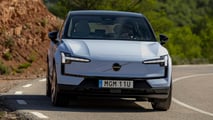The Electrifying YouTube channel decided to roll out the Hyundai Kona Electric for a head-to-head comparison of the features, capabilities, and pricing with the new Volvo EX30. While at first glance, you might expect the EX30 to come away with a major win, this is not a one-sided comparison by any means.
Get Fully Charged
A Quick Takeaway of the EX30 and Kona Electric
The EX30 has fast charge speeds and is more attractive inside and out, but it is not spacious and has an overreliance on the central touchscreen. The Kona has a longer driving range, heads-up-display, large rear seat and excellent V2L features.
Regarding styling, both hosts agree that the EX30 easily takes the win. The Volvo has a nice clean look, even if it isn’t particularly bold or exciting. Nicki describes the Volvo’s overall aesthetic as having a “kind of coherent, Scandinavian finish to it.” Nicola especially appreciates the EX30’s 20-inch wheels, even if they aren’t the most efficient option.
When it comes to the Kona Electric’s aesthetics, the car takes a bit of a beating from front to back. The first punch is thrown at the Kona's forward-facing, off-center charge port. “It’s not the most coherent car,” Nicola says. “It’s bubbly at the front, jiggy-jagged down the side, and has a little booty in the back.”

On the interior, the hosts have differing tastes. The Kona Electric has a perfectly functional interior, with a nice driver’s cockpit. Most importantly for Nicola, most functions in the Kona are tied to actual buttons rather than the central screen. Nicki feels that while buttons are nice, the Kona’s cockpit is overkill and criticizes the interior for being too grey.
While the Kona might go too far in one direction, the EX30 takes it to the extreme in the other direction. Almost all primary functions are assigned to the 12.3-inch screen. Nicola is not a particular fan of this Tesla-styled cockpit “I just want a nob and a button. That’s all I’m asking for.”

Nicki and Nicola can agree that the Hyundai's heads-up display is great, and are disappointed that it is not available on the Volvo.
The rear seat of the Kona is also a clear winner. The little Hyundai is nice and roomy with heated seats and plenty of ports including a vehicle-to-load (V2L) outlet. The rear of the EX30 does have good headroom thanks to the panoramic sunroof. But legroom is very tight and the Volvo lacks heated rear seats and a V2L outlet.
Both vehicles have small but quite functional frunks. Whereas the trunk space comparison is a blowout, with the Kona holding 466L (16.5 cubic feet) and the EX30 only carrying 318L (11.2 cubic feet).

On the road, the Volvo drives very well, feeling a bit quicker than the Hyundai. They’re driving the single-motor rear-wheel drive version here, which has 272 hp and feels surprisingly sporty. The twin motor version does have better performance, but even the single motor EX30 has a respectable 5.3 second 0-60 time.
The Hyundai does not have the same level of performance, with 215 hp and a 7.8 second 0-60 time. The Kona Electric is also front-wheel drive and is prone to frequent tire squeals and loss of traction if you gun it from a standstill. Constantly pinging driver alert notifications are also irritating and go off for everything from slightly wandering eyes, hugging too close to lane markers and every single speed limit change. Still, the regen paddles are a nice feature and the ride itself is very good for a car this size and this price range.
On range and charging, there is a split decision. The Kona has a driving range of 319 miles WLTP and takes 41 minutes to charge from 10 to 80%. The EX30 has a 295-mile WLTP range but takes only 28 minutes to charge 10-80% at a DCFC.
In the end, there are two recommendations: for those with children, the Hyundai Kona Electric is the obvious answer thanks to its larger rear seat and trunk space. For couples and singles, the Volvo EX30 is the way to go.
Which car is right for you? Let us know in the comments below.
Gallery: 2025 Volvo EX30 First Drive







Gallery: 2024 Hyundai Kona Electric US














